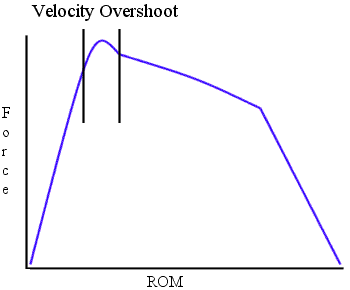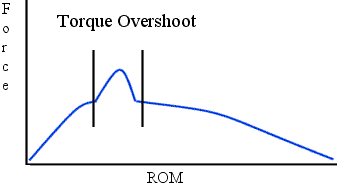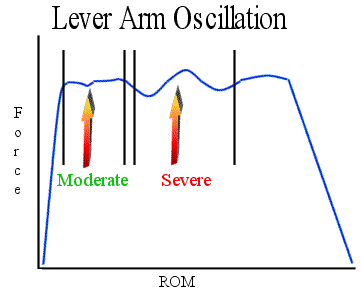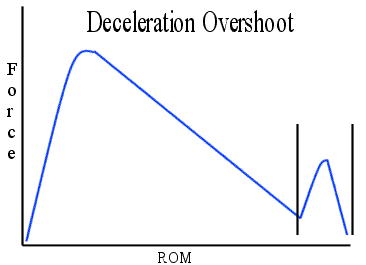Acceleration and deceleration affect the isokinetic range of motion significantly (see here for a full description). It has been shown that including the acceleration and deceleration portions of the range of motion during a test can seriously affect the results once the speed is increased (Taylor et al. 1991).When any test begins (isokinetic concentric or eccentric) there is a brief moment where the speed is equal to zero or in other words there is no movement. The tested body part must then be accelerated to the pre-set speed, as the speed approaches that which has been pre-selected the dynamometer slows the movement to the pre-set speed. It has been show by many authors (Perrine and Edgerton, 1978, Sapega et al., 1982, Taylor et al., 1991 and Wilson, Walshe and Fisher, 1997) that the speed during acceleration and deceleration can be up to double the pre-set velocity. This means that the machine has to have a braking effect on the movement which can cause a spike as the movement is slowed to the pre-set velocity. At slower speeds this spike is small (Brown, 2000) but increases in magnitude with increasing speed.
As the velocity during acceleration/deceleration has been higher than the pre-set speed this is called velocity overshoot (and can be seen below).

Because of this overshoot and the consequent braking phase the torque seen during this braking period is called torque overshoot. As has already been said Brown (2000) states this phenomena increases with increasing speed and in many cases the torque spike may be much higher than the maximal peak torque seen at any other point during ROM (see below).

Authors claim it is important to remove any torque/velocity overshoot artefacts before assessing peak torque (or most other measurement as they are reliant on peak torque). Most new dynamometers take a certain percentage of the ROM away before presenting the final results (called smoothing on the Cybex and windowing on the Biodex which has been shown by Wilk et al. (1994) to improve data reliability) but they are all currently unable to remove all impact artefacts as the subject may take longer than expected to accelerate to the pre-determined speed. It then becomes the operators responsibility to recognize impact artefacts and factor these out of the subject’s results.
Unfortunately, the artefacts are not restricted to the acceleration and deceleration phases. Immediately following the acceleration phase the speed of motion is braked to such a degree that the speed falls slightly below the lower margin of the pre-set angular velocity (PAV). When this occurs the dynamometer allows a certain degree of further acceleration which has often been called lever arm oscillation. This can also occur because of the length of the lever arm in that the longer the lever arm is the more the distal end of the tested chain attempts to attain the speed at the proximal end. it will then have to slow once more to approximate the speed of the proximal end. In my opinion this has been best described by Brown (2000)who compared lever arm oscillation to the oscillation seen in a long fishing pole. When the pole is grasped at one end and whipped forwards the distal end oscillates for a short period until it stabilizes. An example of this oscillation can be seen below.

Isometric spikes or impact artefacts occur right at the end of ROM. Here, the machine physically stops the subject causing an isometric contraction of the muscle which is combined with the force already contained in the movement in the tested muscle joint system and mechanical apparatus. This creates a final spike and can be one again larger than any of the peak torque measurements taken during the rest of testing. An example may be seen here.

If you are very unlucky (or not a very experienced tester) then you may get combinations of the three and sometimes even all three.